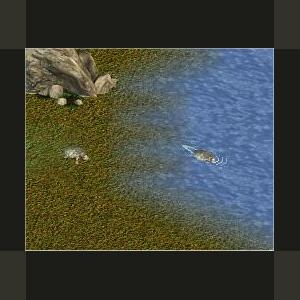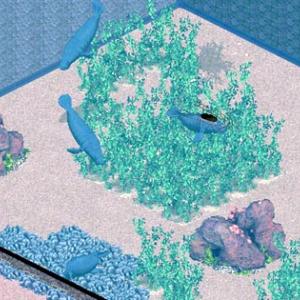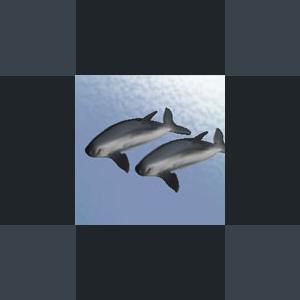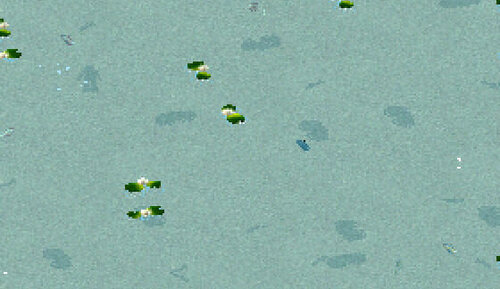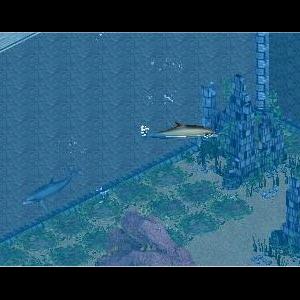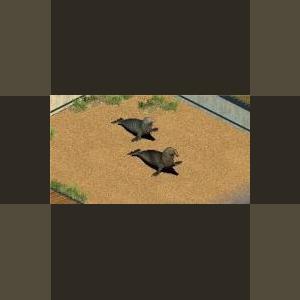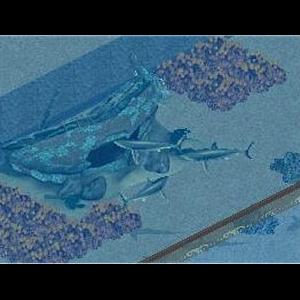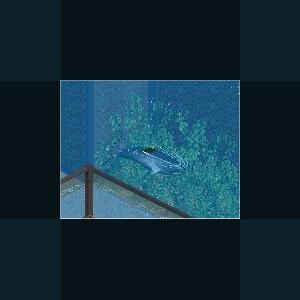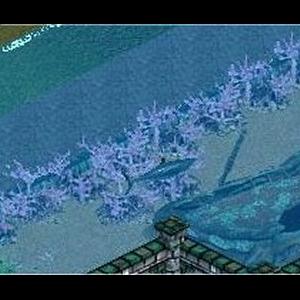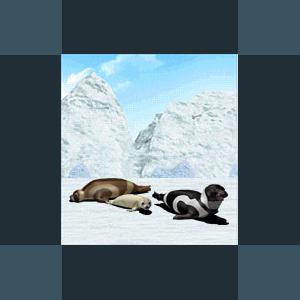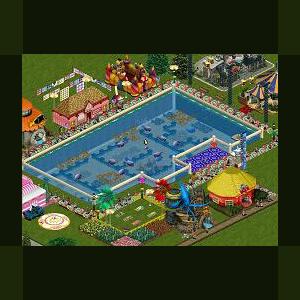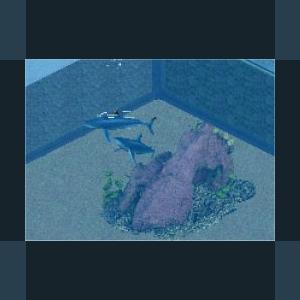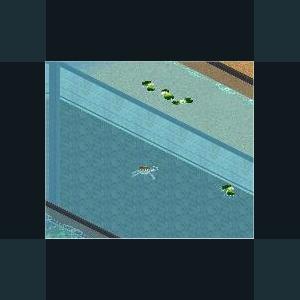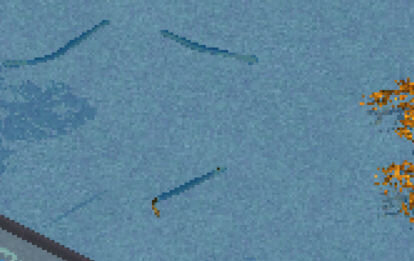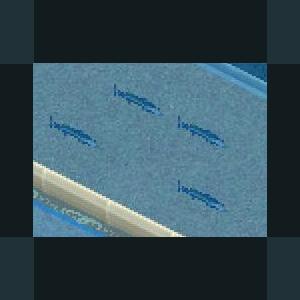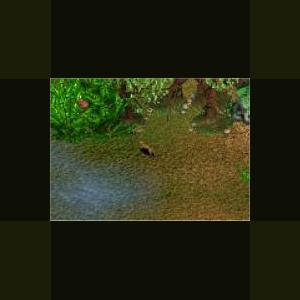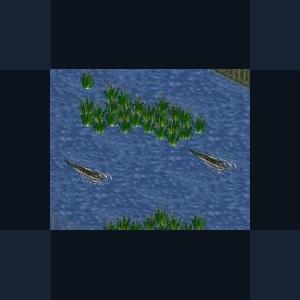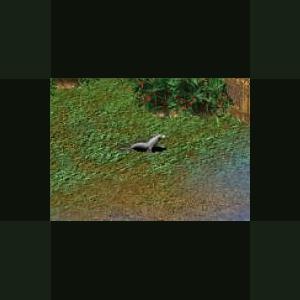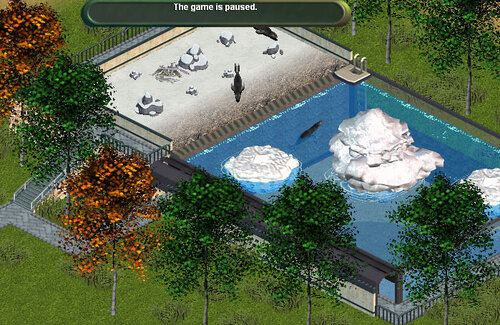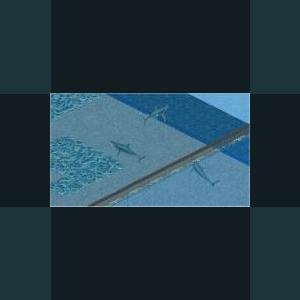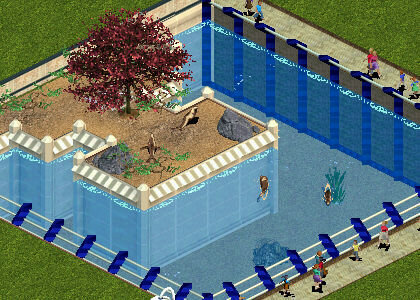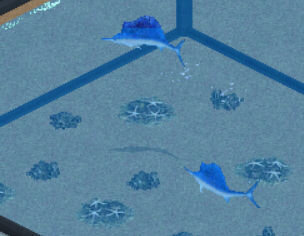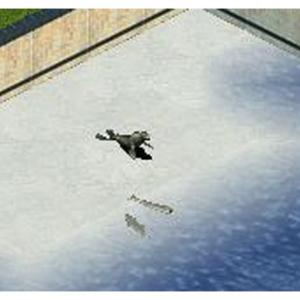Marine
Creatures under the sea
47 files
-
Western Pond Turtle by Ghirin
By Guest
Western Pond Turtle
Author: Ghirin
The western pond turtle is native to the Pacific Northwest of North America. Its preferred habitat is near streams, rivers and slow-moving bodies of water. The diet includes insects, small fish, and frogs.
Created by Ghirin 2005
548 downloads
Updated
-
West African Manatee by BigCatKeeper
By Guest
West African Manatee Author: BigCatKeeper
http://www.zoo-tek.com/forums/index.php?download=167
Manatees are large, cylindrically shaped mammals, with forelimbs modified in to flippers, no free hind limbs, and the rear of the body in the form of a flat, rounded, horizontal paddle. The flexible flippers are used for aiding motion over the bottom, scratching, touching and even embracing other manatees, and moving food into and cleaning the mouth. Its upper lip is modified into a large bristly surface, which is deeply divided. It can move each side of the lips independently while feeding. The general coloration is grey.
The West African manatee weighs less than 500 kg (1100 lb). Adults are generally 3 - 4 m (10 - 13') long. It inhabits coastal areas, estuarine lagoons, large rivers that range from brackish to fresh water, freshwater lakes and the extreme upper reaches of rivers above cataracts. This manatee species is dependent on emergent or overhanging, rather than submerged, vegetation. Populations in some rivers depend heavily on overhanging bank growth, and those in estuarine areas feed exclusively on mangroves. Seasonal movements in response to changes in water level affecting availability of food and/or water salinity have been reported in several areas. An individual manatee may travel 30 - 40 km/day (19 - 25 mi/day) through lagoons and rivers.
The West African manatee occurs from Senegal to Angola; its numbers continue to decrease. The population decline has been attributed largely to hunting and incidental capture in fishing nets. Despite legal protection, the manatee is still hunted throughout its range. It is sometimes also killed in turbines or control gates of dams. The coastal wetlands that are a major habitat for the manatee have already been heavily damaged and are further severely threatened. Woodcutting is resulting in the extermination of mangrove stands in some areas. Mangrove clearance, as well as erosion due to forest clearance upstream, are resulting in increased sedimentation that silts up lagoons and estuaries.
West African Manatee created by Bigcatkeeper
Many thanks to Professorpaul
464 downloads
0 comments
Updated
-
Vaquita (or Gulf of California Porpoise) by Tasmanian Tiger
By Fern
Vaquita (or Gulf of California Porpoise)
Author : Taz (Tasmanian_tiger)
Category : Tank animal, Critically endangered animal, Cetacean
Updated: July 26, 2013 by Jay to remove unnecessary files and configuration lines and to make some minor adjustments to the animal info.
Current ztd date: July 26, 2013
Compatibility : MM/CC
Description : The vaquita, or also called the 'Gulf of California Porpoise', is one of the smallest cetaceans around. It's about 1.5 meters or 5 feet long. Please note that the version at Taz's site is no longer the most current version, since she is deceased.
390 downloads
0 comments
Updated
-
Trout Pack by Coolperson5
By Guest
A pack of freshwater trout.
This pack includes 5 species of freshwater trout.
Apache Trout
Bull Trout
Cutthroat Trout
Gila Trout
Golden Trout
Each fish needs a 5 square tank of any depth with 2 squares of water lilys and one square of rocks. The zookeeper will say that it needs a mate if it is alone, but it will not affect suitability or happiness.
Have Fun!
This file includes both Trout Pack_CP5Combined.ZTD, which is combined, and the 5 individual files. If the combined .ZTD is used, the others are not needed.
580 downloads
0 comments
Updated
-
Spinner Dolphin by LAwebTek
By Guest
Spinner Dolphin
Author: LAwebTek
Classified Stenella longirostris in 1828 - the specific name referring to this species' long snout. This species is found in tropical and subtropical waters worldwide. There are no subspecies, but there are four distinct Eastern Pacific forms: the Eastern, the Whitebelly, the Costa Rican and the Hawaiian.
The Spinner Dolphin is a slender creature with a long, thin beak to which the distinct forehead slopes gently. The dorsal varies with both age and geographical form; it can lean forward, be curved, or be completely triangular in shape. The flippers are long and pointed, and a stripe links them to the eyes. Eastern Pacific and Costa Rican animals are mainly grey, with other forms usually two- or three-tone. Both the Hawaiian and Whitebelly forms have a dark grey or black dorsal cape, paler flanks and sides, and a creamy-white belly. All forms measure between 1.3 and 2.1m in length, and weigh between 45-75kg.
Units range from a few animals to a few thousand, often mixing with other cetacean species such as Pilot Whales and Spotted Dolphins. They are dramatically acrobatic, with somersaults, high spinning leaps and other aerial movements popular. They vocalise with whistles and clicks, and can travel as fast as 20kph. Spinner Dolphins inhabit both offshore and inshore waters and feed on midwater fish and squid. They are different from other dolphins in that they feeds at night.
Spinner Dolphins are often targeted in the purse-seine and yellowfin tuna fisheries of the eastern Pacific Ocean. Elsewhere, many of these dolphins are accidentally killed in gillnets, and also taken in harpoon fisheries. Some individuals have been kept successfully in captivity for at least 10 years.
2003 LAwebTek
427 downloads
Updated
-
Southern Elephant Seal by Ghirin
By Guest
The southern elephant seal (Mirounga leonina) is the largest living species of pinniped. This large seal is native to the sub-antarctic region.Elephant seals feed on fish and squid. They are know for their long, deep dives in search of prey.
447 downloads
0 comments
Updated
-
Sicklefin Lemon Shark by Ghirin
By Guest
Sicklefin Lemon Shark Author: Ghirin
The sicklefin lemon shark (Negaprion acutidens) is a close relative of the lemon shark. The primary differences between the species are geographic location and fin shape. Sicklefin lemon sharks are native to the Pacific Ocean and their pectoral fins are more curved.
References:
Sharks, Ferrari and Ferrari. 2002
Ghirin 2005
281 downloads
0 comments
Updated
-
Shortfinned Pilot Whale by Ghirin
By Guest
Short-finned Pilot Whale by Ghirin
The short-finned pilot whale (Globicephala macrorhynchus) is a large member of the dolphin family.
It is extremely social and usually travels in large groups.
References:
http://www.acsonline.org/factpack/PilotWhale.htm
www.wikipedia.org
*Inspired by the Zoo Tycoon Brains Trust at the Zoo Tek Forums*
477 downloads
0 comments
Updated
-
Saltwater Bull Shark by Ghirin
By Guest
Saltwater Bull Shark
Author: Ghirin
The bull shark (Carcharhinus leucas) is a large, robust shark found in shallow coastal marine waters worldwide. These sharks will also enter and live in estuaries, freshwater lakes and rivers.
Bull sharks eat both bony fishes and small sharks. In the cooler portions of their range, bull sharks mate during the summer months; however, in the warmer parts of their range they may breed year-round. Females nourish the young internally for 10 to 11 months and give birth to free-swimming pups.
*Inspired by the Zoo Tycoon Brains Trust at the Zoo Tek Forums.
Created by Ghirin 2004
375 downloads
0 comments
Updated
-
Salmon Shark by Ghirin
By Guest
Salmon Shark
Author: Ghirin
The salmon shark (Lamna ditropis) is considered by many to the Pacific Ocean equivalent of the porbeagle. This shark has a similar build and shape as other members of the mackerel shark family. Like the mako, porbeagle and great white, the salmon shark is able to maintain it body temperature several degrees above the surrounding ocean.
This shark prefers the cooler waters of the northern Pacific Ocean and ranges from California to the coasts of South Korea. It is mainly pelagic in habitat but will travel in coastal and epipelagic regions of it range.
Salmon sharks may form schools, but the sexes do not school together. It is a fast swimmer. Its main diet is composed of a variety of fishes including salmon, herring, sardines, cod, and dogfish. They will also consume squid when available.
*Inspired by the Zoo Tycoons Brains Trust at the Zoo Tek Forums.
Created by Ghirin 2004
325 downloads
0 comments
Updated
-
Ribbon Seal by Tasmanian Tiger
By Guest
The ribbon seal of the north pole to add to your zoo!
The ribbon seal is compatible with the emperor penguin, although the emperor penguin doesn't like it, it will accept its presence and cause no problems.
Updated: September 27, 2013 by Jay to remove the background for the male animal list icon, to add animal list icons for the female and young, to remove the top and bottom edges of the purchase menu icons, to adjust the positions of all animations, to make minor adjustments to the animal info, to add the preferred object tooltip for the female and young, to add the capability of a simple surface roll trick for show tanks, to add the capability to use 3 user made toys, to add a purchase menu tooltip, to remove unnecessary files and configuration lines, and to correct configuration mistakes done by the APE program. Please note that the version at Taz's site is no longer the most current version, since she is deceased.
Current ztd date: September 27, 2013
Compatibility : All Game Versions
Description : The ribbon seal or the Histriophoca fasciata grows to a maximum of 1.9 metres in size. It is found in the Arctic and Subarctic regions of the North Pacific Ocean, notably in the Bering Sea and Sea of Okhotsk. It is the only species in the genus Histriophoca. The Ribbon Seal is a medium-sized pinniped from the family called Phocidae. Members of the Phocidae family are also called true seals or earless seals because they lack external ear flaps. Since newborn ribbon seals do not enter the water for a number of weeks, the young of this ribbon seal does not go in water. This Ribbon Seal can use the Ice Floe For Certain Animals By Taz, the Ice Floe For Certain Animals, and the Raft For Certain Animals. The Ribbon Seal is compatible with the Emperor Penguin, although the Emperor Penguin doesn't like it but will accept its presence and cause no problems. However, if the Emperor Penguin is in the same exhibit, then the exhibit must not have the Ice Floe For Certain Animals By Taz, the Ice Floe For Certain Animals, or the Raft For Certain Animals, since the penguin could get stuck on those toys, being that the penguin is not configured for those toys. The Ribbon Seal is also compatible with the Harp Seal made by Taz.
Note: ZT is not used to animals where the adults go in tanks while the young do not. So it can keep changing its mind between the exhibit being suitable and the exhibit needing more salt water terrain and less snow. Whenever it does change its mind and wants more salt water terrain, do so. Eventually it will get to a point where it does not change its mind.
1,204 downloads
Updated
-
Powder Blue Tang by JT (JohnRN1)
By Cricket
Thank you for downloading the Powder Blue Tang. This saltwater fish is compatible with the Cuban Hogfish and is created for the Tek 2012 Anniversary.
"Move the .ztd file into the dlupdate (and not dupdate) folder if one exists in your Zoo Tycoon folder; otherwise move the .ztd file into the Updates folder that is in the Zoo Tycoon folder."
The default is C:\Program Files\Microsoft Games\Zoo Tycoon
Thank you to Fern and Jay for their invaluable encouragement, guidance and expertise.
--JohnT--
325 downloads
Updated
-
Porbeagle by Ghirin
By Guest
Porbeagle Shark Author: Ghirin
http://www.zoo-tek.com/forums/index.php?download=142
The porbeagle (Lamna nasus), also known as the Atlantic mackerel shark and bluedog, is a member of the mackerel shark family. It has the characteristic spindle-shaped body of its close relatives, the shortfin mako and the salmon shark, but has a slightly longer, more conical snout. The dorsal surface of this shark ranges from dark blue to gray and the belly is often white, but this varies by population.
Porbeagles have two distinct populations: A population that dwells in the North Atlantic and a second population that lives in the southern portions of the Pacific, Atlantic, and Indian Oceans. They are mainly found in open ocean, but can also be found in coastal waters.
Unlike most fish, the porbeagle and its close relatives have the ability to retain heat produced by metabolism. Special vascular structures known as retia mirabilia serve as counter-current heat exchangers between the muscles and viscera. The porbeagle can also alter blood flow, giving the shark more control over its body temperature and allowing it to raise its body temperature 12 degrees F above the surrounding water. This gives the porbeagle the ability to be a fast swimmer.
Porbeagles feed on a variety of bony fishes and will eat cephalopods when available. They are ovoviviparous and usually have litters of 1 to 6 pups with 4 being the most common.
*Inspired by the Zoo Tycoon Brains Trust at the Zoo Tek Forums
Created by Ghirin 2004
321 downloads
0 comments
Updated
-
Pig-Nosed Turtle by Ghirin
By Guest
The pig-nosed turtle (Carettochelys insculpta), also known as the Fly River turtle, is a unique species of freshwater turtle native to northern Australia and southern New Guinea. The turtle gets its name from the way its nostrils are located in the front of its snout.
Even though the pig-nosed turtle is a freshwater turtle, it resembles a sea-going turtle because it has flippers instead of front legs. These turtles have been found in a variety of habitats, including rivers, estuaries, lagoons, lakes, swamps and water pools. The waterway bottoms are usually covered with gravel and the banks are usually heavily forested.
Pig-nosed turtles are omnivorous, but have a preference for fruit and leaves.
References:
http://www.tortoise.org/archives/pignose.html
http://www.whozoo.org/Intro2002/RacheLoftin/RNL_flyriverturtle.html
http://www.chelonia.org/carettochelys_gallery.htm
Created Ghirin 2005
452 downloads
0 comments
Updated
-
Pelagic Sea Snake by Khaydar
By Khaydar
Adopt a Pelagic Sea Snake (Hydrophis platurus), also known as the Yellow-bellied sea snake.
Animal guide:
Cannot be used in original Zoo Tycoon: Needs Marine Mania
Minimum happiness needed for chance of breeding: 96.
Liked foliage:
Sea Anemone (MM), Brittle Sea Star (MM), Orange Cup Coral (MM)
Divercate Tree Coral (MM), Feather Duster Worm (MM), Fire Coral (MM)
Kelp (MM), Sea Lettuce (MM), Red Gorgonian (MM), Sargassum (MM)
Sand Dollar (MM), Sea Cucumber (MM), Seaweed (MM), Sea Grass (MM)
Sea Sponge (MM), Stove Pipe Sponge (MM), Tube Worm (MM)
Purple Sea Urchin (MM)
Liked rock:
Small Ocean Floor Rock (MM), Medium Ocean Floor Rock (MM)
Large Ocean Floor Rock (MM), Medium Coral Formation (MM)
Large Coral Formation (MM), Iceberg (MM), Isle Rock (MM)
Number of animals allowed per exhibit: 1-3 with 25 squares each.
A suitable exhibit for 2 of this animal has 50 squares containing terrain of:
50 Salt Water using 8 Sargassum (MM) most liked plant
and using 16 Small Ocean Floor Rock (MM) most liked rock.
Other liked items:
Giant Pacific Clam (MM), Treasure Chest (MM), Deep Sea Diver Statue (MM)
204 downloads
- snake
- khaydars animal
- (and 1 more)
0 comments
Updated
-
Pacific Baracuda by BigCatKeeper
By Guest
Pacific Barracuda Author: BigCatKeeper
The Pacific barracuda is slim-bodied, has a tapered head, a long thin snout, and large canine teeth in a lower jaw that projects beyond the upper. It also has a forked tail, large eyes, and short, widely separated dorsal fins with 5 dorsal spines and 10 dorsal rays. The anal fins have 2 spines followed usually by 9 rays. Greyish-black on the back with a blue tinge, shading to silvery white on the sides and belly, it has a yellowish tail which lacks the black blotches on the sides of the body that are characteristic of other barracudas. Large females have a charcoal black edge on the pelvic and anal fins, whereas the male fins are edged in yellow or olive.
The Pacific barracuda is shorter than the great barracuda. It reportedly can grow up to 5 feet but has only been recorded to 4 feet; it rarely weighs more than 10 pounds, and though fish of about 12 pounds have been captured, most of the fish caught by anglers are much smaller. They grow to at least 11 years old, and the females grow larger than the males, with most fish over 8 pounds and all fish over 11 pounds being female. The growth rate is similar in both sexes until the fourth year of life, when the females begin to grow a bit faster. Pacific barracudas occur along the Pacific coast of North America from Alaska to Magdalena Bay, Baja California, though their common range is between Point Conception, California, and Magdalena Bay. The Pacific barracuda is the only barracuda found along the Pacific coast of North America. Pacific barracudas prefer warmer water. Only caught off of California during the spring and summer, they are caught in Mexican waters throughout the year, reflecting a northerly spring migration and a southerly fall migration. Spawning takes place off outer Baja California in the open ocean, peaking in June but extending from April to September. The eggs are pelagic and once they hatch, the young come inshore and stay in the shallow, quiet bays and coastal waters while they grow. By July, fry spawned in early spring are about 4 inches and average about 16 inches a year later. A few males spawn in their first year, and all by their second year, while most females spawn in their second year and all by their third year. When small, they travel in schools, though adults are normally solitary. They are naturally curious and attracted to shiny objects.
The Pacific barracuda feeds by sight instead of smell, and eats small anchovies, smelt, squids, and other small, schooling fish.
Pacific Barracuda created by Bigcatkeeper
Idea from Zoo Tycoon Brains Trust (Professorpaul)
Updated : August 3, 2009 by genki to fix the following:
- Cleaned up file
- Made corrections to the .uca to fix warnings that were coming up on the .uca checker
- Fixed LCID error, which can cause game crashes for some people
- Removed unneeded .wav files (was already linked to in-game sounds)
Update 8 August 2013 to add back the 2009 update info
389 downloads
0 comments
Updated
-
Otter Civet by Ghirin
By Guest
Otter Civet
Author: Ghirin
The otter civet (Cynogale bennettii) resides in swampy wetlands and borders of streams and rivers in tropical southeast Asia and Indonesia. It is semi-aquatic and resembles a small sea otter. The civet otter is thought to ambush small mammals and birds when they come to the water to drink; it may also eat crustaceans, mollusks, fish and fruit.
References:
Walker’s Mammals of the World. Nowak, 1999
Created by Ghirin 2003
386 downloads
0 comments
Updated
-
Orinoco Crocodile by Ghirin
By Guest
Orinoco Crocodile by Ghirin
The Orinoco crocodile (Crocodylus intermedius) is one of the largest predators found in South America.
At one time, this crocodile ranged from the northern coast of South America to the foothills of the Andes Mountains, but today its numbers have been severely reduced and it is critically endangered.
**Inspired by the Zoo Tycoon Brains Trust at the Zoo Tek Forums.
Reference:
http://www.flmnh.ufl.edu/natsci/herpetolog...cs/csp_cint.htm
381 downloads
0 comments
Updated
-
Nerpa Baikal Seal by Ghirin
By Guest
The nerpa or Lake Baikal seal (Pusa sibirica) is one of the smallest true seals in the world. This species of seal is native to Lake Baikal in Siberia and spends its entire life in freshwater.
296 downloads
0 comments
Updated
-
Leopard Seal by Khaydar
By Khaydar
Adopt a Leopard Seal (Hydrurga leptonyx) to your zoo.
Leopard Seal description:
Minimum happiness needed for chance of breeding: 90.
Liked foliage:
none
Liked rock:
Small Ocean Floor Rock (MM), Large Ocean Floor Rock (MM), Iceberg (MM), Isle Rock (MM), Large Rock
Small Rock - Medium, Small Rock - Small, Large Snowy Rock - Medium
Large Snowy Rock - Large, Small Snowy Rock - Medium, Small Snowy Rock - Small
Number of animals allowed per exhibit: 1-3 with 60 squares each.
A suitable exhibit for 2 of this animal has 120 squares containing terrain of:
72 Salt Water, 12 Gray Stone, 36 Snow
using no foliage
and using 29 Small Ocean Floor Rock (MM) most liked rock.
Other liked items:
Tank Filter (MM), Snowy Rock, Ice Floe (MM)
Credits to zerosvalmont for the model and mesh
Made by khaydar
309 downloads
- khaydars animal
- seal
- (and 1 more)
Updated
-
Lemon Shark by Ghirin
By Guest
Lemon Shark Author: Ghirin
The lemon shark (Negaprion brevirostris) is a large shark that inhabits the coastal waters of the Atlantic ocean, primary the coasts of the Americas and western Africa. A second population is also found in the Pacific coastal waters off of North and South America.
Lemon sharks form loose, same-sex groups that may come inshore during the day, but usually return to deeper waters at night. They are often found near the bottoms of of the bodies of water where they feed on bony fishes and crustaceans.
This species of shark is viviparous, giving birth to live pups (litter size ranges 4-17 pups). The pups live in shallow waters for the first years before venturing out into deeper waters.
*Inspired by the Zoo Tycoons Brains Trust at the Zoo Tek Forums
Created by Ghirin 2004
378 downloads
0 comments
Updated
-
Japanese Sea Lion by Coolperson5
By Guest
Japanese Sea Lion (Zalophus japonicus) is thought to have become extinct in the 1950s.
Prior to 2003 it was considered to be a subspecies of California Sea Lion as Zalophus californianus japonicus. However, it was subsequently reclassified as a separate species. Some taxonomists still consider it as a subspecies of the California Sea Lion. It has been argued that japonicus, californianus, and wollenbaeki are distinct species because of their distant habitation areas and behavioral differences.
They inhabited the Sea of Japan, especially around the coastal areas of the Japanese Archipelago and the Korean Peninsula. They generally bred on sandy beaches which were open and flat, but sometimes in rocky areas.
Currently, several stuffed specimens can be found in Japan and the National Museum of Natural History, Leiden, the Netherlands brought by Philipp Franz von Siebold. The British Museum possesses a pelt and 4 skull specimens.
426 downloads
0 comments
Updated
-
Indo-Pacific Sailfish by Khaydar
By Khaydar
Adopt an Indo-Pacific Sailfish (Istiophorus platypterus) for your zoos.
Animal guide
Cannot be used in original Zoo Tycoon: Needs Marine Mania.
Minimum happiness needed for chance of breeding: 96.
Liked foliage:
Sea Anemone (MM), Brittle Sea Star (MM), Orange Cup Coral (MM)
Divercate Tree Coral (MM), Feather Duster Worm (MM), Fire Coral (MM)
Sargassum (MM), Sand Dollar (MM), Sea Cucumber (MM), Sea Grass (MM)
Sea Sponge (MM), Stove Pipe Sponge (MM), Tube Worm (MM)
Purple Sea Urchin (MM)
Liked rock:
Small Ocean Floor Rock (MM), Medium Ocean Floor Rock (MM)
Large Ocean Floor Rock (MM), Medium Coral Formation (MM)
Large Coral Formation (MM), Isle Rock (MM)
Number of animals allowed per exhibit: 1-6 with 30 squares each.
A suitable exhibit for 2 of this animal has 60 squares containing terrain of:
60 Salt Water
using 4 Brittle Sea Star (MM) most liked plant
and using 43 Small Ocean Floor Rock (MM) most liked rock.
Other liked items:
Giant Pacific Clam (MM), Treasure Chest (MM), Deep Sea Diver Statue (MM)
291 downloads
- living animal
- khaydars animal
- (and 1 more)
Updated
-
Hooded Seal by Ghirin
By Guest
The hooded seal (Cystophora cristata) occurs mainly in the northern Atlantic ocean from Newffoundland to Greenland. Individuals have been reported as far west as iceland and as far south as Florida. The hooded seal gets it name from the enlarged, inflatable nose of the male. To inflate the hood, the male closes his nostrils and fills his nose with air. The male can also blow a bright red ballon (made from the nasal septum) out of one nostril instead of inflating the hood. Females also have a hood, but it smaller and is not inflatable.
Hooded seals prefer to live in deep water areas where there is thick floating ice. During early spring, females haul out on the sea ice to give birth to their pups. This is also the mating season, when males display to the females, using their hoods as threats to rival males.
Hooded seals feed on fish, cephalopods, shrimp, and mussels.
References:
Walker's Mammals of the World, Nowak, 1999
http://www.bbc.co.uk/nature/wildfacts/factfiles/602.shtml
Photograph:
http://www.americazoo.com/goto/index/mammals/330.htm
Created by Ghirin 2003
308 downloads
0 comments
Updated
-
Hawaiian Monk Seal by Ghirin
By Guest
Hawaiian monk seals (Monochus schauinslandi) are found in the outer islands of the Hawaiian chain. Their genus, Monachus, is the only seal genus found in the tropics.
412 downloads
0 comments
Updated

